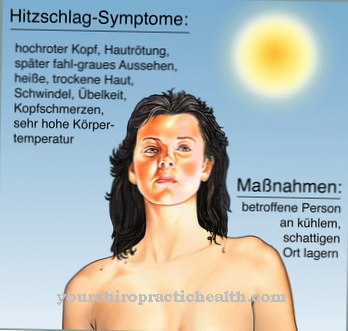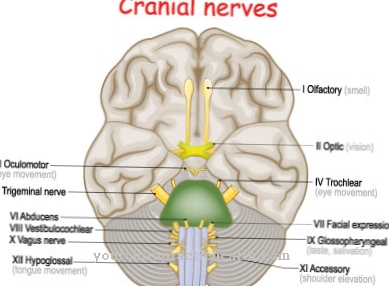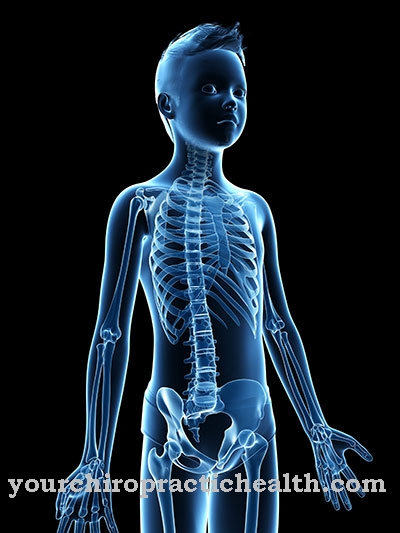heatstroke, Heat collapse, Overheating, Heat stroke or Hyperthermia syndrome is a life-threatening disorder in which the body temperature can reach a critical value of over 39 degrees Celsius due to intense heat and physical stress. The body is still no longer able to cool the body down to normal temperatures due to its inadequate heat regulation through sufficient sweat production. This leads to circulatory shock or death from overheating. Urgent medical help must be called immediately (emergency number 112).
What is heat stroke?

A heatstroke, Heat stroke or Hyperthermia syndrome is a disorder of the body as a result of faulty heat regulation. Heat stroke often occurs in summer when people are exposed to too much sun and / or heat without giving off enough body heat in the form of sweat (sweating) or body temperature.
The main purpose of sweating is to regulate the temperature against overheating, because sweat and air cause what is known as perspiration, which cools the body down through the cold sweat. In medicine, heat stroke is counted among the heat damage, which can also include sunstroke.
If the body temperature is more than 40 degrees Celsius without the fever being present, one speaks of heat stroke. The untreated consequence can lead to death, because from a body temperature of about 42 degrees Celsius, the protein coagulates in the cells (e.g. muscle cells).
causes
The causes for heatstroke are obvious. Mostly in summer, when temperatures are over 30 degrees Celsius and the sun is warming the body unhindered, this can lead to heat stroke. Often, hard physical work or sport also favors heat stroke, as the body temperature increases further and the circulation is also challenged.
If the body is not cooled down again by drinking enough and sweating and the body temperature remains above 40 degrees Celsius, heat stroke is almost inevitable. Elderly people in particular tend to dress too much, even in summer and in extreme heat, so that it is difficult for body heat to escape.
This build-up of heat then leads to unconsciousness or fainting. In addition, the circulation can be life-threateningly disturbed. Urgent medical help is then necessary.
Symptoms, ailments & signs
Typical symptoms of heat stroke are an increased body temperature of over 40 degrees Celsius as well as a high pulse, dizziness and nausea. The skin feels hot and dry due to the reduced sweat production and is reddened. Blood pressure is normal at the beginning, but drops as the disease progresses.
In the further course of the disease, a circulatory collapse can occur, associated with impaired consciousness and a coma. Without intensive medical treatment, heat stroke can lead to death. Heat stroke overloads the cardiovascular system, which can lead to sweating, dizziness and palpitations. Panic attacks can accompany this.
In the area of the brain, the insufficient blood flow can cause what is known as cerebral edema. Water flows from the vessels into the brain and causes swelling, which manifests itself in increasing headache and neck pain, apathy, confusion and coma.
In infants and young children, heat stroke can be recognized by reddened, dry skin and increased irritability. The baby also refuses to eat and shows signs of impaired consciousness. In severe cases, there are also seizures and loss of consciousness. In addition, the body temperature quickly rises to over 41 degrees Celsius.
Course of disease
The course of a Heat stroke depends on the intensity of the body temperature and the time how long the person concerned has been overheated. Therefore, if you suspect heat stroke, you should call an emergency doctor immediately. The doctor will then try to stabilize the circulation and lower the body temperature again.
If third parties do not help, heat stroke can have life-threatening effects. Helpers should not leave the person affected by heat stroke alone, but try to lay them on their side and, in extreme cases, in the case of cardiac arrest and respiratory arrest, also use chest compressions and mouth-to-mouth resuscitation.
Complications
Heat stroke is caused by the overheating of the human organism, so this clinical picture is of course also associated with serious complications. It is not uncommon for various side effects to occur in connection with heat stroke, which make it necessary to be treated by a doctor. These side effects include severe headache, nausea, vomiting, dizziness, drowsiness, fever and a general state of exhaustion.
Those who seek medical treatment early in such a case will be able to effectively combat or eliminate the above-mentioned complications. However, if you do not seek treatment by a doctor at this point, you run a very high risk. Not infrequently, the individual clinical pictures worsen considerably, so that a visit to the doctor is inevitable.
In most cases, heat stroke is associated with long-lasting headaches, usually accompanied by a feeling of nausea. Vomiting several times is also not uncommon if there is severe heat stroke. The following applies: Heat stroke naturally brings with it many different complications, which can worsen considerably if left untreated.
However, those who seek medical and drug treatment at an early stage will be able to avoid or effectively alleviate the existing complications. The person concerned should definitely get out of the sun, as there may be an acute danger to life.
When should you go to the doctor?
If symptoms such as headache, nausea, or dizziness are noticed after being in the sun for a long time, it may be heat stroke. A doctor should be consulted if the symptoms persist for more than a few hours and increase in intensity as the disease progresses. If there are other complaints such as palpitations or impaired consciousness, a doctor must be consulted immediately. In the event of a circulatory collapse or other complications, the emergency services must be alerted.
People who already suffer from a disease of the heart or the cardiovascular system should consult a doctor immediately if the symptoms are mentioned. The same applies to pregnant women and the elderly. With children, they should see a pediatrician on the same day if there are signs of heat stroke. If in doubt, we recommend going to the nearest hospital. The right person to contact in the event of heat stroke is your family doctor or a specialist in circulatory diseases. The medical emergency service can provide initial information about the symptoms of the hyperthermia syndrome and suggest further measures to the person affected.
Doctors & therapists in your area
Treatment & Therapy
After a heatstroke The emergency doctor (emergency number 112) will first try to protect the patient from a circulatory collapse.
At the same time he will try to lower the body temperature again. First treatment measures can also be carried out by passers-by or companions. This includes:
1. Move the person suffering from heat stroke to a shady, cool place
2. Position the patient in the stable lateral position, if possible keep the upper body slightly elevated
3. Cool down the body with cool air (fan), cool compresses (towels) or cool packs.
4. Observe the heat stroke sufferer until the emergency doctor arrives
5. If breathing and the pulse stop, cardiopulmonary resuscitation must be started immediately
Usually the doctor then takes patients to a hospital for further treatment. Further measures to stabilize the circulation and body temperature are then initiated here.
Outlook & forecast
When diagnosed with heat stroke, the person affected should not be left alone and kept awake, as the patient's condition can quickly worsen. Breathing and pulse should also be constantly monitored. If the patient has fainted, raise the patient's legs so that the blood can flow better to the brain. If you are unconscious, it is advisable to lie on your side as the blood flow to the brain and other organs can also be disturbed. If breathing stops or circulatory failure occurs, chest compressions and ventilation must be performed.
Heat stroke can affect anyone, including the young and healthy. A fatal end is more likely to occur in children, as their temperature regulation is not yet fully developed, as well as in older or chronically ill people. Therefore, the course of heat stroke depends not only on the factors that caused it, but also on the age and health of the person affected. Depending on the severity, collapse, accompanied by fever and nausea, up to a complete breakdown of the circulatory system and severe brain damage can occur. In the worst case, heat stroke is fatal. The majority of those affected survive heat stroke without permanent damage.
Prevent
Of course you can heatstroke prevent. Logically, the first preventive measure should be to avoid excessive body temperature increases. This means that weather-oriented clothing is worn in summer and a hat or parasol when the sun is strong. Furthermore, you should drink enough and the body should be cooled down by taking a cool shower or bathing in cool water.
Lastly, excessive physical exertion should be avoided. This includes exercise and heavy physical work. Furthermore, you should stay in the shade more often. Hot teas have also proven to be beneficial, as they serve as a fluid supply on the one hand and make the body sweat on the other, so that the sweat can cool the body temperature.
Aftercare
A mild heat stroke usually does not require medical treatment or follow-up care. With the self-administered first aid measures, the symptoms usually disappear within a few hours. However, if medical treatment by a family doctor or even an emergency doctor became necessary due to persistent symptoms or the severity of the heat stroke, appropriate follow-up care must be provided.
If cerebral edema develops, the prescribing diuretics must be taken strictly according to the doctor's instructions. This is the only way to promote fluid excretion via the kidneys and further reduce the edema. If the edema was acutely life-threatening and an operation was performed, good wound hygiene must be ensured in the weeks after the operation.
In younger children, behavioral changes must be observed over the next few days. These can manifest themselves through abdominal pain, sensitivity to touch, sleep disorders, sensitivity to light and noise or general malaise. Seizures, fever, clouding of consciousness or vomiting are also possible. All of these symptoms may indicate meningitis caused by sunstroke and require immediate medical consultation and treatment.
In general, all those affected should avoid prolonged exposure to the sun and physical exertion in the near future, ensure adequate hydration and protect themselves from renewed sunstroke with suitable headgear or a parasol.
You can do that yourself
If heat stroke is suspected, first aid measures must be taken immediately. The affected person should first be brought to a cool, shady place. The head and neck can be cooled with cold compresses. With a slight sunstroke, a cold shower and some rest can often help. In addition, it must be ensured that the person concerned drinks enough - preferably water or apple spritzer - and remains conscious. If there is a disturbance of consciousness or nausea, it is best to alert the emergency doctor immediately. Until then, those affected should be positioned slightly upwards so that the head and upper body are well supplied with blood.
If you have severe heat stroke, watch for panic attacks and symptoms of dehydration or apathy. If symptoms occur, treatment by a doctor is essential. Then, in any case, bed rest and rest is indicated until the symptoms subside. Heat stroke in infants and young children requires prompt treatment in the hospital or from an emergency doctor.The same applies here: take the person affected out of the sun, cool down and give them plenty to drink. In addition, preventive measures should be taken in order to avoid renewed heat stroke.


.jpg)

.jpg)
.jpg)








.jpg)













